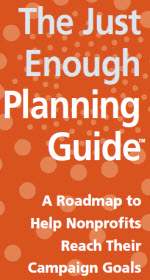For some people, planning a campaign is less about following a process and more about following their instincts. Long-time campaigners believe they have a feel for the road. With each new campaign, they load the station wagon with all the gear that has served them well in the past – all the tools and the
processes. They have a destination in mind, shift into autopilot, and the campaign strategy unfolds from reflex and memory. Experience has taught them well – they pack light and know all the shortcuts. Or do they?
For less experienced campaigners, the tendency is to overpack for fear they’ll find themselves down the road lacking a key tactic or guide. They bring it all along for the ride. Then, they often hit every attraction and marker along the way, even when it pulls them off track from their true destination – if they were even clear about their destination when they started.
Organizations looking to run effective campaigns need to find the middle ground between the underpackers and the overpackers. They must chart the “happy planning medium” between the Autobahn speedsters and the country road rovers. They need a go-to planning source that offers assistance with the campaign at hand and campaigns ahead – a guide that can help them define their destination, assess whether or not they can get there, launch them in the right direction, measure their progress and (when necessary) be flexible enough to make changes on the fly.
After much effort, we could not find the campaign planning tool we were seeking, so we created this: The Just Enough Planning Guide™. It borrows from what we consider to be the best practices out there and provides organizations and coalitions with a planning process that gives them a clear sense of where they
are going, the best way to get there, and what to expect along the way.
The guide takes you through nine stages of campaign planning. During each stage, you will make specific decisions. The guide offers a variety of ideas, questions and examples to help direct your decisions, but ultimately, the decisions are yours to make.
The nine stages to successful campaign planning are:
1. Confirm that a campaign is possible. This is the time to step back and assess the viability of a campaign. Are the stars aligned for this effort to be successful?
2. Set a clear, measurable goal that is achievable. Your plan needs to be focused on achieving a very specific goal. Your goal is your raison d’être. Are you trying to make something happen or stop something from happening? There is a difference.
3. Chart your course. Much like a road trip, there are likely many ways to get to your goal. You will use your knowledge of the field and the external environment to determine the best steps to your goal.
4. Anticipate conditions. Visualize all possible scenarios – the good, the bad and the ugly – so your plan includes strategies for leveraging opportunities and mitigating challenges, including identifying your opposition.
5. Know how to make headway. What will propel you down your path? What major campaign activities can help you get from Point A to Point B?
6. Prioritize your target audiences. Now that you have a strategy, stay focused by prioritizing who you need to engage to win, and when.
7. Put a public face on your campaign. Give the effort a name and a personality that is memorable and easily understood. You want people to recognize what you are about and not have to guess.
8. Operationalize your campaign. Based on the activities you think will help you make headway, determine which campaign tactics you will need: from intellectual knowledge to government relations to public mobilization to communications to coalition building to fundraising.
 9. Stay on track. Build evaluation mechanisms into your plan that will tell you when you are making progress and when you need to stop and make a midcourse correction. Meet regularly with your team to discuss your progress.
9. Stay on track. Build evaluation mechanisms into your plan that will tell you when you are making progress and when you need to stop and make a midcourse correction. Meet regularly with your team to discuss your progress.
Remember: there is no one-size-fits-all campaign model. Your campaign is unique and therefore your plan and decisions will be unique. Look to examples of successful efforts for inspiration, not hidden answers.
For a free download of the planning guide and accompanying tool, access The Just Enough Planning Guide™ here.
About the Author: Spitfire Spitfire Strategies offers nonprofits and foundations communications planning, counsel and training to help them create positive social change. Our goal is to help social change organizations use their voice in a strong, clear and compelling way to articulate their vision of a better world. We craft effective communications strategies and bring ideas to life.







